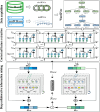DGCLCMI: a deep graph collaboration learning method to predict circRNA-miRNA interactions
- PMID: 40264118
- PMCID: PMC12016396
- DOI: 10.1186/s12915-025-02197-9
DGCLCMI: a deep graph collaboration learning method to predict circRNA-miRNA interactions
Abstract
Background: Numerous studies have shown that circRNA can act as a miRNA sponge, competitively binding to miRNAs, thereby regulating gene expression and disease progression. Due to the high cost and time-consuming nature of traditional wet lab experiments, analyzing circRNA-miRNA associations is often inefficient and labor-intensive. Although some computational models have been developed to identify these associations, they fail to capture the deep collaborative features between circRNA and miRNA interactions and do not guide the training of feature extraction networks based on these high-order relationships, leading to poor prediction performance.
Results: To address these issues, we innovatively propose a novel deep graph collaboration learning method for circRNA-miRNA interaction, called DGCLCMI. First, it uses word2vec to encode sequences into word embeddings. Next, we present a joint model that combines an improved neural graph collaborative filtering method with a feature extraction network for optimization. Deep interaction information is embedded as informative features within the sequence representations for prediction. Comprehensive experiments on three well-established datasets across seven metrics demonstrate that our algorithm significantly outperforms previous models, achieving an average AUC of 0.960. In addition, a case study reveals that 18 out of 20 predicted unknown CMI data points are accurate.
Conclusions: The DGCLCMI improves circRNA and miRNA feature representation by capturing deep collaborative information, achieving superior performance compared to prior methods. It facilitates the discovery of unknown associations and sheds light on their roles in physiological processes.
Keywords: CircRNA-miRNA interaction; Collaborative filtering; Graph neural networks; LSTM; Word2vec.
© 2025. The Author(s).
Conflict of interest statement
Declarations. Ethics approval and consent to participate: Not applicable. Consent for publication: Not applicable. Competing interests: The authors declare no competing interests.
Figures






Similar articles
-
Hither-CMI: Prediction of circRNA-miRNA Interactions Based on a Hybrid Multimodal Network and Higher-Order Neighborhood Information via a Graph Convolutional Network.J Chem Inf Model. 2025 Jan 13;65(1):446-459. doi: 10.1021/acs.jcim.4c01991. Epub 2024 Dec 17. J Chem Inf Model. 2025. PMID: 39686716
-
Prediction of circRNA-MiRNA Association Using Singular Value Decomposition and Graph Neural Networks.IEEE/ACM Trans Comput Biol Bioinform. 2023 Nov-Dec;20(6):3461-3468. doi: 10.1109/TCBB.2022.3222777. Epub 2023 Dec 25. IEEE/ACM Trans Comput Biol Bioinform. 2023. PMID: 36395130
-
Integrating Transformer and Graph Attention Network for circRNA-miRNA Interaction Prediction.IEEE J Biomed Health Inform. 2025 Aug;29(8):6105-6113. doi: 10.1109/JBHI.2025.3561197. IEEE J Biomed Health Inform. 2025. PMID: 40232907
-
Integration of Bioinformatic Predictions and Experimental Data to Identify circRNA-miRNA Associations.Genes (Basel). 2019 Aug 24;10(9):642. doi: 10.3390/genes10090642. Genes (Basel). 2019. PMID: 31450634 Free PMC article. Review.
-
A Survey of Deep Learning for Detecting miRNA- Disease Associations: Databases, Computational Methods, Challenges, and Future Directions.IEEE/ACM Trans Comput Biol Bioinform. 2024 May-Jun;21(3):328-347. doi: 10.1109/TCBB.2024.3351752. Epub 2024 Jun 5. IEEE/ACM Trans Comput Biol Bioinform. 2024. PMID: 38194377 Review.
Cited by
-
MVHGCN: Predicting circRNA-disease associations with multi-view heterogeneous graph convolutional neural networks.PLoS Comput Biol. 2025 Jun 19;21(6):e1013225. doi: 10.1371/journal.pcbi.1013225. eCollection 2025 Jun. PLoS Comput Biol. 2025. PMID: 40536898 Free PMC article.
-
GGCRB: A Graph Neural Network Approach for Predicting CircRNA-RBP Interactions Using Structural and Sequence Features.ACS Omega. 2025 Jul 22;10(30):33662-33674. doi: 10.1021/acsomega.5c04524. eCollection 2025 Aug 5. ACS Omega. 2025. PMID: 40787315 Free PMC article.
References
-
- Memczak S, Jens M, Elefsinioti A, Torti F, Krueger J, Rybak A, Maier L, Mackowiak SD, Gregersen LH, Munschauer M. Circular RNAs are a large class of animal RNAs with regulatory potency. Nature. 2013;495(7441):333–8. - PubMed
-
- Conn SJ, Pillman KA, Toubia J, Conn VM, Salmanidis M, Phillips CA, Roslan S, Schreiber AW, Gregory PA, Goodall GJ. The RNA binding protein quaking regulates formation of circRNAs. Cell. 2015;160(6):1125–34. - PubMed
-
- Huang G, Li S, Yang N, Zou Y, Zheng D, Xiao T. Recent progress in circular RNAs in human cancers. Cancer Lett. 2017;404:8–18. - PubMed
MeSH terms
Substances
Grants and funding
LinkOut - more resources
Full Text Sources
Miscellaneous

